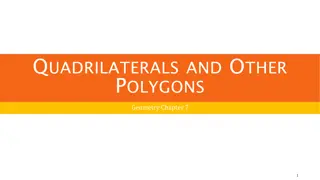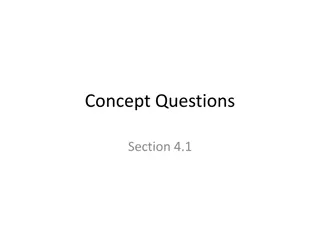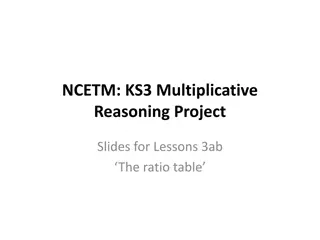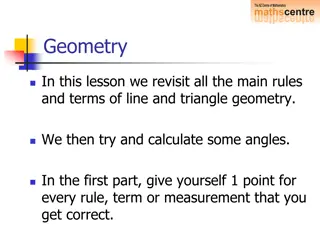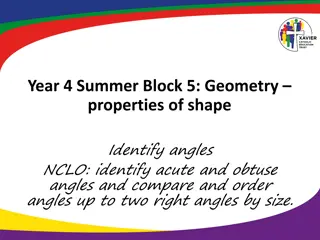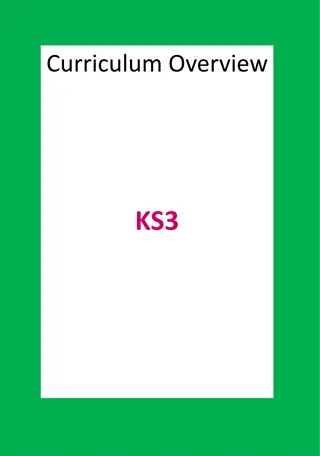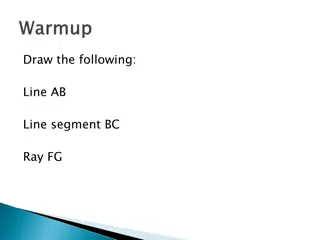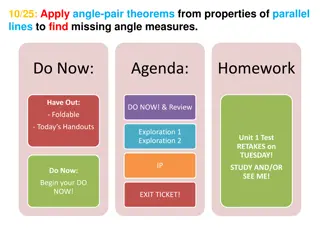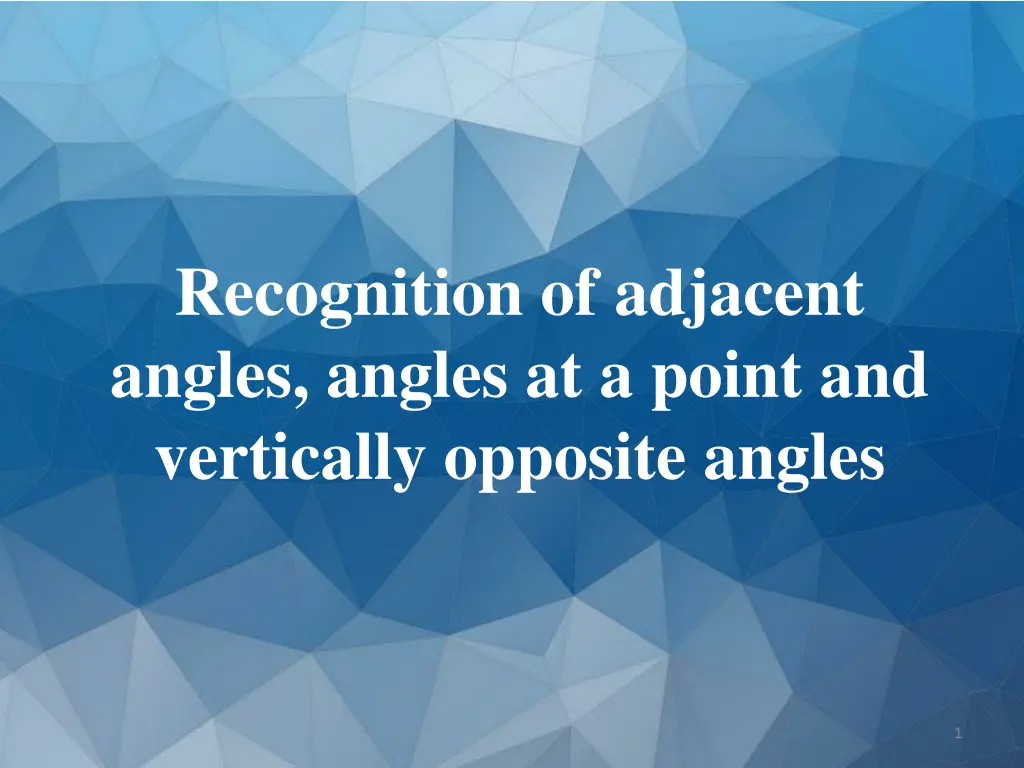
Understanding Adjacent Angles and Angle Relationships
Explore the concept of adjacent angles, angles at a point, and vertically opposite angles. Discover how to recognize adjacent angles, identify complementary and supplementary angles, and understand angle relationships in this informative guide.
Download Presentation

Please find below an Image/Link to download the presentation.
The content on the website is provided AS IS for your information and personal use only. It may not be sold, licensed, or shared on other websites without obtaining consent from the author. If you encounter any issues during the download, it is possible that the publisher has removed the file from their server.
You are allowed to download the files provided on this website for personal or commercial use, subject to the condition that they are used lawfully. All files are the property of their respective owners.
The content on the website is provided AS IS for your information and personal use only. It may not be sold, licensed, or shared on other websites without obtaining consent from the author.
E N D
Presentation Transcript
Recognition of adjacent angles, angles at a point and vertically opposite angles 1
Adjacent angles a b In the figure, a and b lie on different sides of their common arm OB. They also have a common vertex O. We call a and b a pair of adjacent angles. 3
Adjacent angles Which of the following pairs of angles are adjacent angles? 1. 2. q d p c *no common arm 3. 4. s a r b *no common vertex 4
Adjacent angles Which of the following pairs of angles are adjacent angles? 5. 6. y x m n * no common vertex 7. 8. u h w k *not lying on different sides of the common arm 5
Adjacent angles a b If the pair of adjacent angles a and b together form a right angle (i.e. 90 ), a and b are said to be complementary. They are called complementary angles. 6
Adjacent angles a b We can say: a is a complementary angle of b, and b is a complementary angle of a. 7
Adjacent angles a b If AOC is a straight line, then we call a and b a pair of adjacent angles on a straight line. 8
Adjacent angles Do you remember what type of AOC is? What is the size of AOC ? Straight angle Straight angle 180 Take a look at a and b again in the figure on the left. a What do you discover? b 9
Adjacent angles a b When AOC is a straight line, AOC becomes a straight angle (i.e. 180 ). a + b = 180 10
Adjacent angles a b When the pair of adjacent angles a and b together form a straight angle (i.e. 180 ), a and b are said to be supplementary. They are called supplementary angles, (i.e. a is a supplementary angle of b, and b is a supplementary angle of a). 11
Adjacent angles Let s focus on the following figure. b a c AOD is a straight line. The angles a, b and c have a common vertex O. Besides, a and b, b and c are two pairs of adjacent angles. The angles a, b and c are also called adjacent angles on a straight line. 12
Adjacent angles AOD is a straight line AOD = 180 a + b + c = 180 b a c Conclusion: The sum of adjacent angles on a straight line is 180 . Abbreviation: adj. s on st. line 13
Example & Application In the figure, AOD is a straight line. Find a. AOB + BOC + COD = 180 (adj. s on st. line) a + 48 + 65 = 180 Don t forget to write the abbreviation. a + 113 = 180 a = 67 14
Adjacent angles q r p Conversely, if p + q + r = 180 in the above figure, we can conclude that POS is a straight line. 15
Example In the figure, (a) is HOF a straight line? (b) is EOG a straight line? (a) HOF = 26 + 90 + 64 (b) EOG = 64 + 115 = 180 = 179 HOF is a straight line. 180 EOG is not a straight line. 16
Angles at a point a b d c In the figure, a, b, c and d have a common vertex O. Also, a and b, b and c, c and d, d and a are four pairs of adjacent angles. We call a, b, c and d angles at a point. 18
Angles at a point What is the name of this type of angle? What is its size? 360 Round angle Round angle Now, look at a, b, c and d in the figure a on the left. What can you conclude? b d c 19
Angles at a point The adjacent angles at a point a, b, c and d form a round angle. a b d a + b + c + d = 360 c Conclusion: The sum of adjacent angles at a point is 360 . Abbreviation: s at a pt. 20
Example & Application Find a in the figure. AOB + BOC + COD + DOA = 360 ( s at a pt.) a + 38 + 82 + 116 = 360 a + 236 = 360 a = 124 21
Vertically opposite angles c a b d In the figure, two straight linesAB and CD intersect at O, forming four angles a, b, c and d at a point. The angles a and b have no common arm. We call a and b a Similarly, c and d are another pair of vertically opposite angles. pair of vertically opposite angles. 23
Vertically opposite angles Which of the following pairs of angles are vertically opposite angles? 1. In the figure, AOC is a straight line. 2. In the figure, both AOC and BOD are straight lines. c b d a *c and d have a common arm. *BOD is not a straight line. 24
Vertically opposite angles Which of the following pairs of angles are vertically opposite angles? 4. In the figure, ABCD is a straight line. 3. In the figure, both AOC and BOD are straight lines. h e k f *h and k have no common vertex. 25
Vertically opposite angles c a b d COD is a straight line COA + AOD = 180 (adj. s on st. line) a + c = 180 a = 180 c 26
Vertically opposite angles c a b d AOB is also a straight line AOD + DOB = 180 (adj. s on st. line) c + b = 180 b = 180 c 27
Vertically opposite angles c a b d c a = b Similarly,c = d Conclusion: When two straight lines intersect, the vertically opposite angles are equal. Abbreviation: vert. opp. s 28
Example & Application In the figure, both AOC and BOD are straight lines. Find a. AOB = COD (vert. opp. s) a = 101 29
Exercise 30
Exercise 1. Find a in the figure. AOB + BOC + COD + DOA = 360 ( s at a pt.) a + 50 + 28 + 70 + 132 = 360 a + 280 = 360 a = 80 31
Exercise 2. In the figure, BOE is a straight line. = 25 (a) Find r. (b) Is AOD a straight line? (a) DOE + COD + BOC = 180 (adj. s on st. line) 3r + r + 80 = 180 4r = 100 r = 25 32
Exercise 2. In the figure, BOE is a straight line. = 25 (a) Find r. (b) Is AOD a straight line? (b) AOD = r + 80 + 69 = 25 + 80 + 69 = 174 180 AOD is not a straight line. 33
Exercise 3. In the figure, AOC and BOD are straight lines. Find a and b. AOB + BOC = 180 (adj. s on st. line) a + 123 = 180 a = 57 34
Exercise 3. In the figure, AOC and BOD are straight lines. Find a and b. Any alternative method? AOD = BOC (vert. opp. s) AOE + EOD = BOC b + 97 = 123 b = 26 35
Exercise 4. In the figure, AOC and BOD are straight lines. Find a and b. COE + EOB + BOA = 180 (adj. s on st. line) a + 57 + 40 = 180 a + 97 = 180 a = 83 36
Exercise 4. In the figure, AOC and BOD are straight lines. Find a and b. DOC = AOB (vert. opp. s) = 40 OCD + CDO + DOC = 180 ( sum of ) b + 75 + 40 = 180 b + 115 = 180 b = 65 37
~The End~ 38

